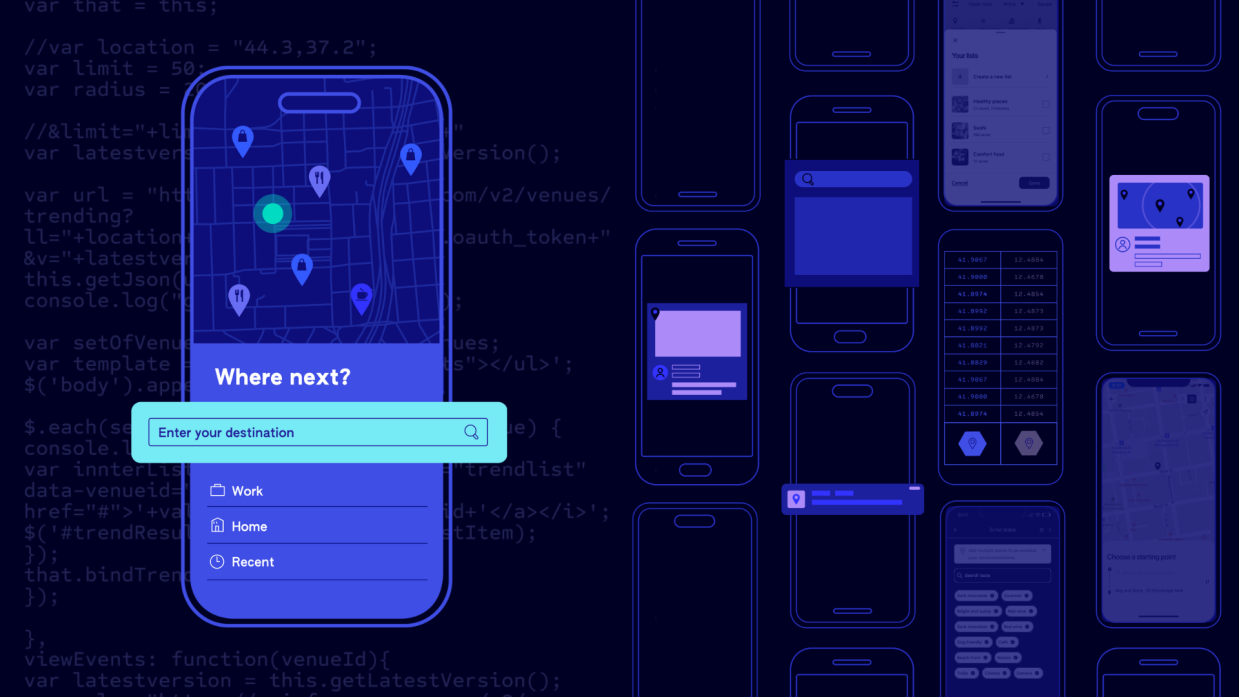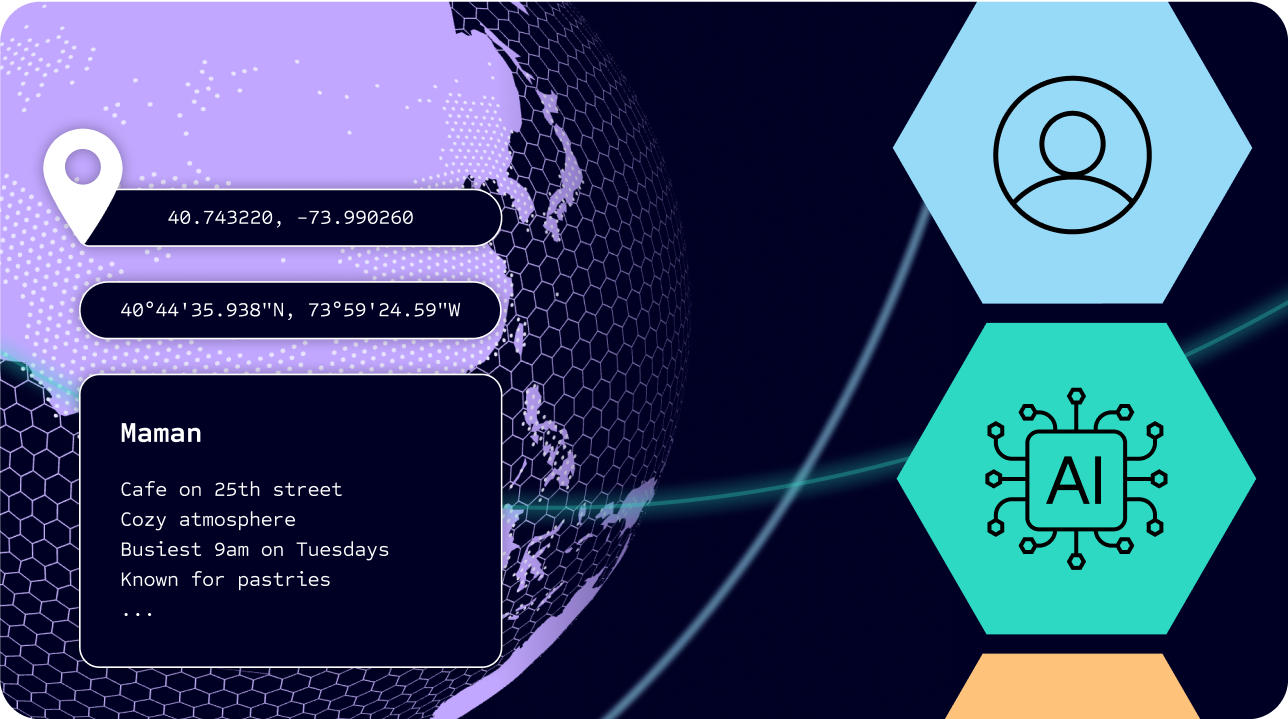The digital age has changed the way we find information. Instead of flipping through the Yellow Pages, users turn to mobile and web applications to find locations and information about points of interest (POI) (i.e. Google Maps). Most developers of these apps don’t have their own databases containing information on POI. Therefore, they must rely on alternative sources.
In addition, developers are always seeking ways to improve the user experience. One of the best ways to accomplish this is through personalization –– by tailoring product recommendations and customizing messages for the individual, users are more likely to trust a brand, make a purchase, and be loyal to the brand for future needs.
For developers experiencing these challenges, having the right application programming interfaces (APIs) is the key to organic growth. Foursquare’s Places API offers access to a geospatial database of 120M+ POIs and rich content from 100K+ trusted sources, providing real-time venue search, discovery, and ranking. In other words, Foursquare’s Places API is like a library that mobile or web applications can quickly resort to when a user requests information about POI.
For developers, better, more precise POI data means a more enjoyable experience for users. Here, we explore the different tools our Places API offers for location-based apps to enhance customer experience.
How Places API Enhances the User Experience
To understand how Places API improves user experience, it’s important to first understand what an API is and how it works. Standing for application programming interface, an API is a software intermediary that allows two applications to interact with each other in the technological ecosystem. User-friendly APIs are all around us with advanced protocols that dictate how software applications share data and functionalities.
Everyday applications of APIs include functionalities for Internet of Things (IoT) devices, SaaS applications, mapping apps, and social media platforms. APIs are a resourceful tool because they allow applications to share features, instead of developing the capabilities from scratch.
For easier access and enhanced compatibility with Java and most other programming languages, modern APIs are designed for HTTP domains. When a user of a mobile or web application makes an action, such as searching for a specific venue in a map app, Places API translates that action into HTTPS format. The application then sends it as a request to Places API with an API key.
From there, Places API uses the instructions in the request to search its database for relevant information regarding the end user’s action. Places API returns one of the following responses containing the requested information:
- JSON: Standing for JavaScript Object Notation, JSON is a lightweight format for storing and transporting data. It is often used when data is sent from a server to a web page.
- XML: Standing for eXtensible Markup Language, XML plays an important role in many different IT systems. It is often used for distributing data over the Internet.
The information is then displayed on the application for the user to see.
Allowing Users to Find the Top-Recommended Places Near Them
Users unfamiliar with an area need trustworthy location data to understand what’s around them. Our Places API enhances user experience by providing accurate information on the top-recommended places nearby. Users can search for places offering unique products, services, or experiences using a location and querying by name, category name, telephone number, taste label, or chain name.
With our Places API, app builders can enable their end-users to discover local destinations with ease, as well as in-depth insights with photos, reviews, tips, and more. This helps users make more informed decisions about the POI around them, enhancing their experience in both the app and in the physical world. For example, if a user wishes to start their morning with a fresh cup of coffee, they can search the keyword “coffee” to access a list of recommended cafes and coffee shops in their area.
Atmosfy uses Places API’s location features to enhance its discovery app, which is used by individuals to explore retail locations and dining through video, to help inform where they go to eat, shop, and more. To query its vast content library, Atmosfy uses a combination of location awareness based on where users currently are, user input of where they intend to go, along with its own personalization algorithms. The app then matches it against a user’s tastes to show them hyperlocal experiences they’re likely to be interested in. Places API helps provide inputs for Atmosy’s algorithms so they can deliver the most relevant content to their users.
Location Matching & Check-ins
To better serve users and provide them with more POI, data accuracy requires knowing where they are in the world. Location matching through Places API allows developers to detect where their users’ devices are and what is around them. Through API integration, developers can use this tool to power location detection and check-in features on their apps.
During the height of the pandemic, when social distancing was at the top of everyone’s mind, one media & tech company sought to find a way to learn consumer visitation patterns at locations across the country. Utilizing Foursquare’s Places API, they were able to gain a better understanding of congestion trends at hundreds of thousands of POIs, at any given time throughout the day. These API features allowed the company to leverage a custom dataset to build location-specific hour graphs, showing consumers what times were the safest to visit a specific POI.
Simple Address Searches
Places API’s address search function allows users to retrieve information for any address including non-places. This feature is used by apps like Beat, the fastest-growing ride-hailing app in Latin America. With the Foursquare Places API, Beat can connect thousands of passengers with nearby available drivers in real-time. Beat users can type pickup and drop-off locations into the app and Places API provides real-time authentication to identify the right destination.
Geotagging Content & Sharing
From Apple lovers to Android users many users want to show off their adventurous sides by showcasing where they are in the world. With Places API, developers can help their users spread the word by offering an experience that allows them to geotag their posts, photos, and other content. Developers can also utilize this feature to their own advantage and provide POI tagging that supports check-ins based on where an end-user’s device is and what is nearby.
How Foursquare Helps Deliver Even Greater Personalization for App Users
Foursquare’s Places API provides app developers with valuable POI data and content from thousands of trusted sources. Developers can use this information to enhance user experience, as well as improve their own capabilities.
Additionally, Foursquare offers a Personalization API that builds off the key features of our Places API. The Personalization API leverages user-generated content such as tastes, venue ratings, reviews, check-ins, current location, and more to power increasingly personalized and detailed app experiences.
Foursquare’s Personalization API includes the following capabilities:
Personalized search
Users are provided with locations based on the keywords they enter and their preferences.
Discovery
To provide users with more intelligent location recommendations, discovery APIs collect information from billions of users. The information collected includes current location, nearby and similar venues, personal preferences, and consumer behavior.
User-generated content
To help users find more accurate POI, these APIs allow apps to gather feedback from recommendations and develop persona profiles to create targeted content.
User management & privacy
To help apps comply with global data and privacy regulations the API provides simplified deletion, export, and management options for end user data.
Foursquare’s Personalization API is built on our best-in-class geospatial database of 120M POIs across 200+ countries, 16B+ human-verified check-ins, and 1B+ photos, tips, and reviews. Developers wanting to learn more about our Personalization API, as well as the features and benefits we offer, can review our Personalization API reference docs.

For applications, enhancing user experience can lead to a wide range of positive outcomes, including improved user engagement, enhanced brand image, increased user retention, and plenty more. Foursquare’s Places API and Personalization API help app developers create a more enjoyable experience for their users. Those wishing to integrate personalization into their web and mobile app developments can create a free Places API account today. Contact us for more information.
Reviewed by: Princess Guzman



